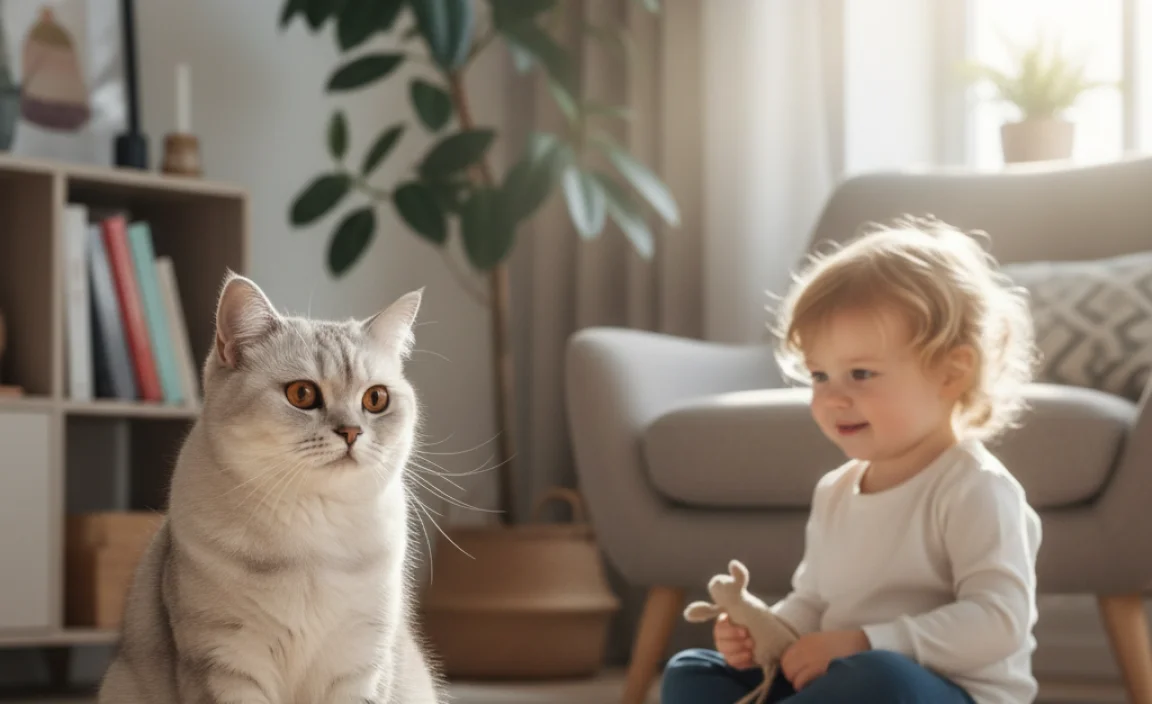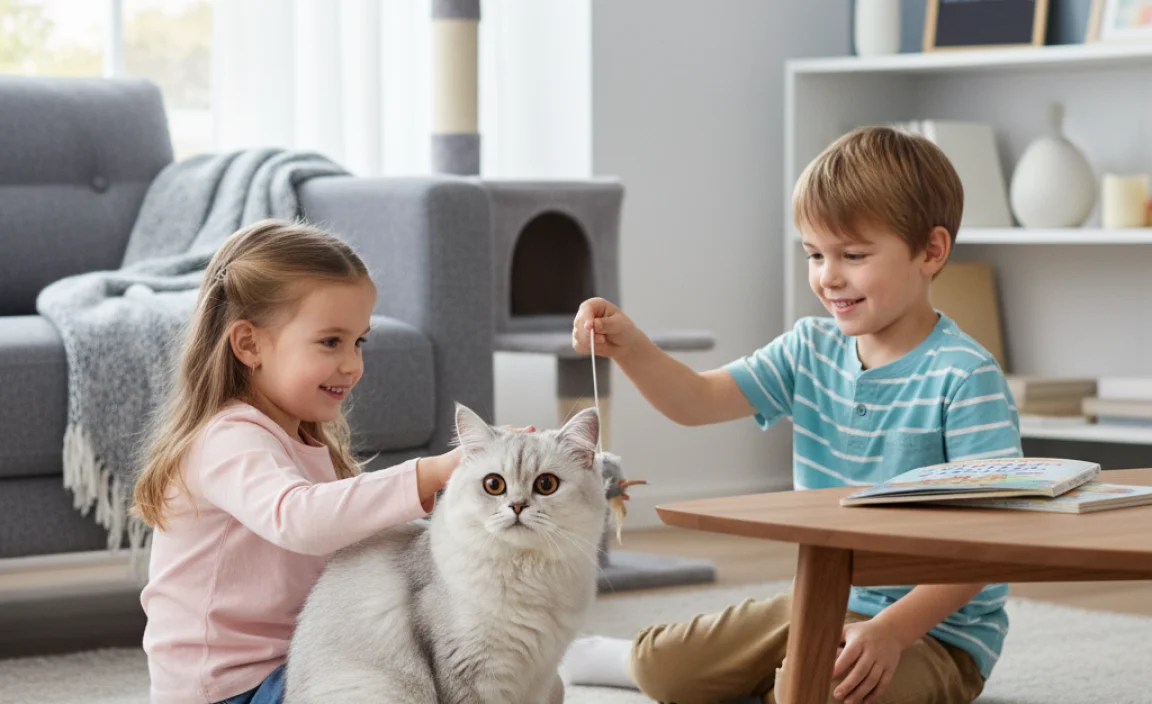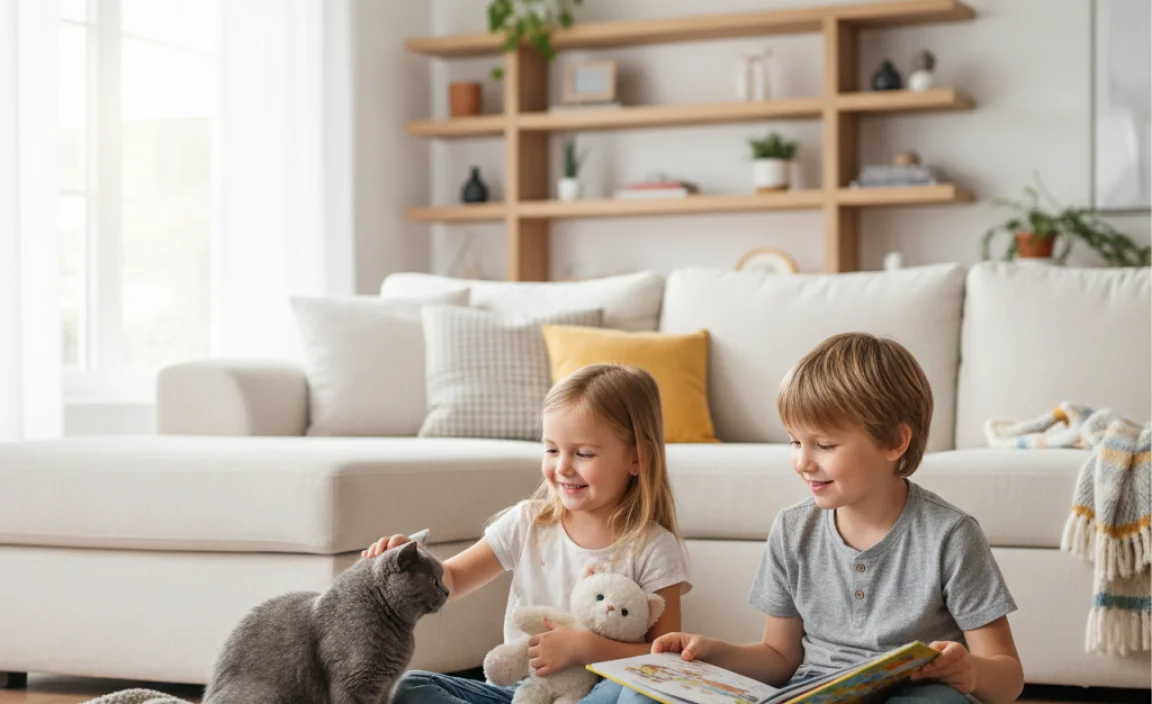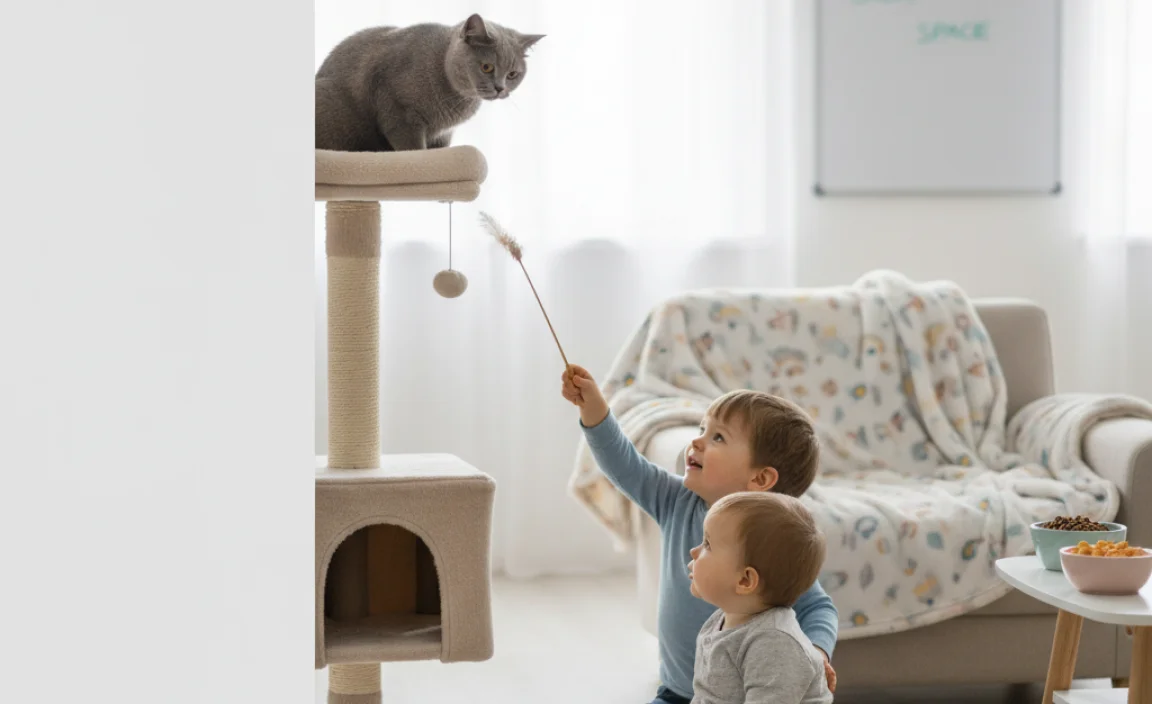Personality traits that make British Shorthairs great with kids: Secret?
Quick Summary: British Shorthairs are often great with kids because of their gentle and patient nature. They’re known for being calm, tolerant, and playful without being overly demanding. Their easygoing attitude and sturdy build make them ideal companions for children who understand how to treat pets respectfully. These cats generally enjoy attention but also appreciate their own space, making them adaptable to family life.
Are you dreaming of a furry friend who’s as happy playing with your kids as they are napping in a sunbeam? Many families find the British Shorthair to be the perfect fit! But is this breed truly a good match for children? It’s a question I hear all the time at BritishShorthairAsk.com. The good news is that their temperament often makes them wonderful family pets. But, like any cat, their individual personality and how they’re raised play a big part.
In this article, I’ll walk you through the specific personality traits that make British Shorthairs so well-suited to life with kids. We’ll explore what to look for, how to ensure a smooth introduction, and how to create a happy, harmonious home for both your children and your new feline friend. Let’s dive in and discover why so many families adore these cuddly companions!
Understanding the British Shorthair Temperament

The British Shorthair is known for its distinctive appearance – a round face, chubby cheeks, and a dense, plush coat. But beyond their looks, it’s their temperament that truly shines, making them excellent family pets. Let’s explore the key personality traits that make these cats so compatible with children.
Calm and Patient Nature
One of the most endearing qualities of the British Shorthair is their calm and patient nature. They’re not typically high-strung or easily agitated, which is a huge plus when they’re around energetic children. According to the RSPCA, a calm environment is essential for a cat’s well-being, and a patient cat is better equipped to handle the occasional accidental poke or clumsy cuddle from a child.
- Tolerance: They generally tolerate a lot of handling, making them less likely to scratch or bite when pestered (though it’s still crucial to teach children to be gentle and respectful).
- Adaptability: British Shorthairs can adapt well to different noise levels and activity, making them suitable for busy households.
- Patience: They tend to be patient, allowing children to learn how to interact with them appropriately.
Affectionate but Not Overly Demanding
British Shorthairs are affectionate cats, but they’re not usually overly demanding of attention. They enjoy being petted and cuddled, but they’re also content to spend time on their own, which is great for families who can’t provide constant attention. The Cornell Feline Health Center emphasizes the importance of understanding a cat’s individual need for attention to ensure a happy relationship.
- Independent streak: They’re not clingy cats, which means they won’t constantly be underfoot, bothering children during playtime.
- Enjoy cuddles: They appreciate a good cuddle session, especially when they initiate it.
- Moderate playfulness: They enjoy playing, but they’re not hyperactive, making them a good match for children who like a calmer playmate.
Playful Without Being Destructive
While British Shorthairs aren’t known for being the most energetic breed, they still enjoy playing. They’re playful without being destructive, meaning they’re less likely to tear up furniture or climb curtains. This is a significant advantage for families with children, as it reduces the risk of accidents and damage. Purina notes that providing appropriate toys and scratching posts can help direct a cat’s energy in a positive way.
- Gentle play: They tend to play gently, making them less likely to accidentally scratch or injure a child during playtime.
- Toy-oriented: They’re often more interested in toys than in roughhousing, which is ideal for supervised play sessions with children.
- Moderate energy levels: Their moderate energy levels mean they’re happy to play for a while and then settle down for a nap, fitting well into a family’s rhythm.
Sturdy Build
The British Shorthair’s sturdy build is another factor that makes them good with kids. They’re not delicate cats, so they can generally withstand the occasional accidental bump or squeeze from a child. However, it’s important to emphasize that children should always be taught to handle cats gently and respectfully, regardless of the breed.
- Resilient: Their robust build makes them less prone to injury from accidental roughhousing.
- Good tolerance: They can generally tolerate being picked up and carried, though it’s essential to teach children how to do this safely and correctly.
- Less fragile: They’re less fragile than some other breeds, making them a better choice for families with young children who are still learning to be gentle.
Introducing a British Shorthair to Children: A Step-by-Step Guide

Bringing a new cat into a home with children requires careful planning and a gradual introduction process. Here’s a step-by-step guide to help ensure a smooth transition and a happy relationship between your British Shorthair and your kids.
Step 1: Prepare the Environment
Before your British Shorthair arrives, prepare a safe and comfortable space for them. This could be a spare room, a quiet corner, or even a large crate. Make sure the space includes:
- A comfortable bed
- Food and water bowls
- A litter box
- Scratching post
- Toys
This designated area will be your cat’s sanctuary, a place where they can retreat and feel safe, especially during the initial days of adjustment. According to TICA, providing a safe space helps cats feel secure and reduces stress during transitions.
Step 2: Initial Introduction (Scent Swapping)
Instead of immediately introducing your cat to the children, start with scent swapping. This allows your cat to get used to the children’s scent and vice versa without direct interaction.
- Use a soft cloth: Gently rub a soft cloth on your cat’s cheeks and body to collect their scent.
- Introduce the scent: Let your children sniff the cloth and gently rub it on their clothes or in their room.
- Repeat: Repeat this process with a cloth that has your children’s scent, introducing it to the cat’s safe space.
This gradual scent introduction helps both the cat and the children become familiar with each other’s presence, reducing anxiety and promoting a sense of security.
Step 3: Supervised Short Visits
Once your cat seems comfortable in their safe space and has had a chance to get used to the children’s scent, you can start with short, supervised visits. The key here is to keep the visits brief and positive.
- Keep it short: Start with 5-10 minute visits.
- Supervise closely: Make sure the children are gentle and respectful. Discourage chasing, grabbing, or loud noises.
- Offer treats: Provide treats or toys to create positive associations with the children’s presence.
Step 4: Teach Children How to Interact with the Cat
Educating your children on how to interact with the cat is crucial. Teach them:
- Gentle petting: Show them how to pet the cat gently, avoiding sensitive areas like the tail or belly.
- Respect boundaries: Explain that the cat needs their own space and shouldn’t be disturbed when sleeping or eating.
- Recognize signs of stress: Teach them to recognize signs that the cat is uncomfortable, such as flattened ears, a twitching tail, or hissing.
Role-playing can be a fun and effective way to teach children how to interact with the cat appropriately. For example, you can pretend to be the cat and have your children practice petting you gently.
Step 5: Gradual Integration
As the cat becomes more comfortable, gradually increase the amount of time they spend with the children. Allow the cat to explore the house at their own pace, and continue to supervise interactions.
- Open access: Once the cat seems confident, give them access to more areas of the house.
- Continue supervision: Keep supervising interactions, especially during the first few weeks.
- Provide escape routes: Make sure the cat always has a way to escape if they feel overwhelmed. This could be a high shelf, a cat tree, or their safe space.
Step 6: Monitor and Adjust
Throughout the introduction process, monitor the cat’s behavior closely. Look for signs of stress, such as hiding, hissing, or changes in appetite. If you notice any of these signs, slow down the introduction process and give the cat more time to adjust. It’s also important to observe the children’s behavior and correct any inappropriate interactions.
Creating a Harmonious Home: Tips for Success

Even with the best preparation, creating a harmonious home for a British Shorthair and children requires ongoing effort. Here are some tips to help you succeed.
Establish Clear Rules and Boundaries
Set clear rules for both the children and the cat. For example:
- No chasing: Children should never chase the cat.
- Gentle handling: Children should always handle the cat gently.
- Respect the cat’s space: Children should not disturb the cat when they’re sleeping or eating.
- No feeding human food: The cat should only be fed cat food.
Consistency is key. Make sure everyone in the family understands and follows the rules.
Provide Plenty of Enrichment
A bored cat is more likely to develop behavioral problems, so it’s important to provide plenty of enrichment. This includes:
- Toys: Offer a variety of toys, such as wand toys, puzzle toys, and plush toys.
- Scratching posts: Provide scratching posts to satisfy the cat’s natural scratching instincts.
- Climbing opportunities: Offer climbing opportunities, such as cat trees or shelves.
- Interactive play: Engage in interactive play sessions with the cat regularly.
Create Separate Spaces
While it’s important for the cat and children to interact, it’s also essential to provide them with separate spaces where they can retreat and have some alone time. This could be a designated cat room, a high shelf, or a comfortable bed in a quiet corner.
Supervise Interactions
Even after the initial introduction period, continue to supervise interactions between the cat and children, especially when they’re playing. This will help prevent accidents and ensure that both the cat and the children are safe and comfortable.
Be Patient and Understanding
Adjusting to a new home and new family members takes time, so be patient and understanding. Don’t expect the cat and children to become best friends overnight. With patience, consistency, and a little bit of luck, you can create a loving and harmonious home for everyone.
Potential Challenges and How to Overcome Them

While British Shorthairs are generally good with kids, there can be challenges. Here’s a look at some potential issues and how to address them:
| Challenge | Solution |
|---|---|
| Cat hiding or avoiding children | Provide more safe spaces, reduce noise levels, and ensure children respect the cat’s boundaries. |
| Scratching or biting | Teach children gentle handling, provide scratching posts, and consult a vet or behaviorist if the behavior persists. |
| Jealousy or resource guarding | Ensure the cat has their own food, water, and toys, and give them plenty of attention when the children are around. |
| Children not respecting the cat | Reinforce rules and boundaries, supervise interactions closely, and use positive reinforcement to encourage gentle behavior. |
| Introducing a kitten to young children | Kittens are more fragile and require very gentle handling. Supervise closely and teach children how to interact gently from the start. |
British Shorthair Breed Standards and Considerations

When considering a British Shorthair, it’s worth understanding the breed standards as defined by organizations like TICA (The International Cat Association). While these standards primarily focus on physical characteristics, they also offer insights into the breed’s expected temperament. A well-bred British Shorthair should exhibit a calm, balanced, and adaptable personality.
Here’s a quick look at key considerations:
- Reputable Breeders: Choose a breeder who prioritizes temperament and health. A well-socialized kitten from a reputable breeder is more likely to adapt well to a family environment.
- Health Screening: Ensure the breeder conducts health screenings for common genetic conditions in the breed, such as hypertrophic cardiomyopathy (HCM) and polycystic kidney disease (PKD).
- Early Socialization: Kittens should be exposed to a variety of sights, sounds, and people from a young age to promote confidence and adaptability.
Understanding these breed-specific factors will help you make an informed decision and set your British Shorthair up for success in your family.
Conclusion
British Shorthairs can indeed be wonderful companions for children, thanks to their calm, patient, and playful nature. Their sturdy build and moderate energy levels make them well-suited to family life, but remember that every cat is an individual. By understanding the breed’s general temperament, following a careful introduction process, and creating a harmonious home environment, you can increase the chances of a happy and fulfilling relationship between your British Shorthair and your kids. As always, patience, understanding, and consistent supervision are key to success. Here’s to many years of purrs, cuddles, and happy memories with your feline friend!
FAQ About British Shorthairs and Kids
Are British Shorthairs good with babies?
British Shorthairs can be good with babies, but supervision is always necessary. Their calm nature can make them tolerant, but they should always have a safe space to retreat to if they feel overwhelmed.
Do British Shorthairs like to be held?
Some British Shorthairs enjoy being held, while others prefer to keep their paws on the ground. It depends on the individual cat’s personality. Always respect their preferences and avoid forcing them to be held.
Are British Shorthairs high-energy cats?
No, British Shorthairs are not high-energy cats. They have moderate energy levels and enjoy playing, but they’re also content to spend time relaxing and napping.
How do I teach my child to be gentle with a British Shorthair?
Teach your child gentle petting techniques, explain the importance of respecting the cat’s boundaries, and supervise their interactions closely. Use positive reinforcement to reward gentle behavior.
What are the signs that a British Shorthair is stressed?
Signs of stress in a British Shorthair include hiding, hissing, flattened ears, a twitching tail, changes in appetite, and excessive grooming.
Are British Shorthairs prone to any health problems?
Yes, British Shorthairs can be prone to certain health problems, such as hypertrophic cardiomyopathy (HCM) and polycystic kidney disease (PKD). Regular veterinary checkups are essential to monitor their health.
How much grooming do British Shorthairs need?
British Shorthairs have a dense coat that requires regular grooming to prevent matting and hairballs. Aim to brush them a few times a week, and more frequently during shedding season.



